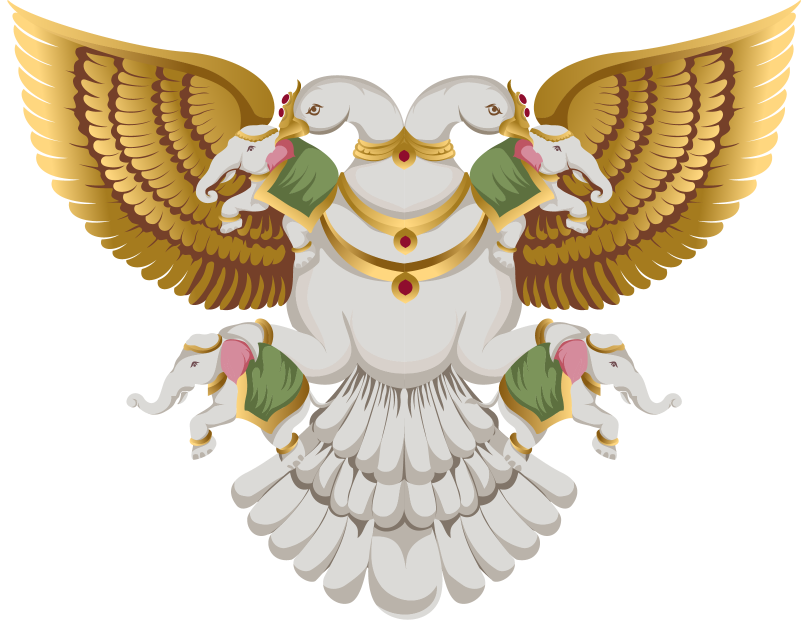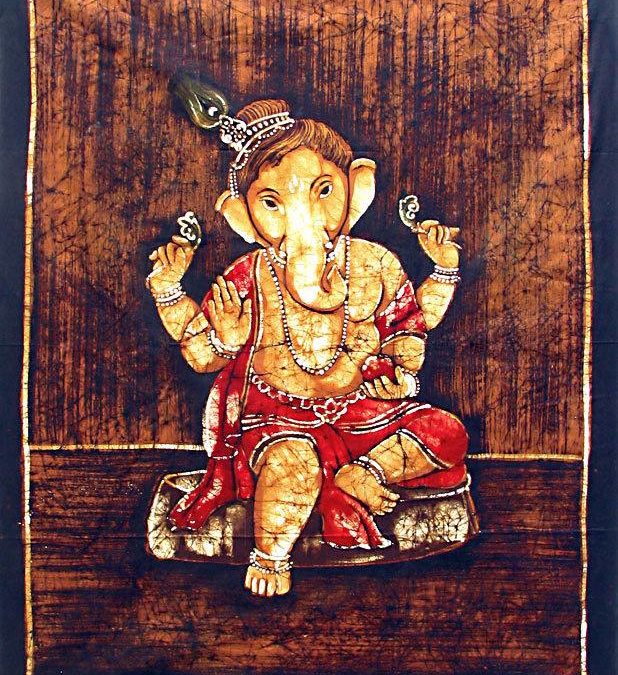Another type of classification is based on the traits for which he is worshiped all over the world. In this classification, there are 32 types of Ganesha, each representing a particular characteristics. So let’s look at each type, beginning with Bala Ganesha.
Bala Ganesha – As the name implies, Bala Ganesha is childlike. Bala Ganesh has four arms and he is holding banana, mango, sugarcane and jackfruit in each hands. And he is holding his favorite ‘Modaka’ in his trunk. Each of the items in his hands represents abundance and fertility.
Taruna Ganesha – This is the youthful Ganesha and this Taruna Ganesha has eight arms. In each hand, he is holding modaka, noose, goad, wood apple, rose apple, tusk, some paddy and sugar cane. The red color further radiates the youthfulness of Taruna Ganesha.
Bhakti Ganesha – Bhakti Ganesha looks all pleasant and shining like a full moon. He is seen fully decorated with flowers from head to toe. He is holding a banana, mango, coconut and bowl of sweet in each of his four hands. Bhakti Ganesh is dear to his devotees and is always showering blessings on the devotees.
Vira Ganesha – Vira Ganesha is the warrior. In his standing posture and with the 16 arms, Vira Ganesha looks commanding. In each hand, he holds weapons, symbolizing powers of mind.
Shakthi Ganesha – Shakthi Ganesha is a guardian and a protector. He has four hands. With one hand, he is blessing all the devotees and in the other three hands, he holds garland, noose and goad. Shakthi Ganesha has one of his ‘Shakthis’ or wives, sitting on his knee. Hence the name, Shakthi Ganesha.
Dvija Ganesha – Dvija Ganesha is regarded as twice born and equivalent to Lord Brahma. He is worshiped for knowledge and wealth. This four-headed Ganesha has four hands, in which he holds a ‘Kamandalu’, Rudrakha, a staff and a leaf scripture.
Siddhi Ganesha – Siddhi Ganesha is an epitome of intellect and success. He sits in relaxed pose, holding flowers, axe, mango and sugar cane in his four hands. With his trunk, he is holding his favorite Modaka sweet.
Ucchista Ganesha – He is known as the Lord of blessed offerings. One of his shakthis is sitting on his left thigh. He has six arms, each arm holding something unique. He is holding a veena, pomegranate, paddy, lotus and rudrakha in each hand.
Vighna Ganesha – As the name suggests, Vighna Ganesha is the Lord of removing obstacles. In this form, he appears similar to Lord Vishnu. He has a Shankhu and Chakra in two of his eight hands. In his other hands, holds a noose, goad, tusk, modaka, a bouquet of flowers, sugar cane, flower arrow and an axe.
Kshipra Ganesha – Kshipra Ganesha is easy to please. He is known to bless the devotees with what they need quickly. In his four hands, Kshipra Ganesha is holding noose, goad, broken tusk and spring of Kalpakavriksha.
Heramba Ganesha – The five-headed Heramba Ganesha is the protector of the weak. This is a very rare form of Ganesha and is seen riding on a lion. He has ten hands. He holds axe, hammer, noose, beads, broken tusk, garland, fruit and modaka in His hands.
Lakshmi Ganesha – Lakshmi Ganesha sits with both his wives, Siddhi and Buddhi, on his either thighs. Lakshmi Ganesha stands for achievement and wisdom. He has eight hands and holds parrot, pomegranate, sword, kamandalu, spring of Kalpakavriksha, noose and goad in his hands.
Maha Ganesha – Maha Ganesha is the most commonly worshiped form of Lord Ganesha. He has ten hands and is holding broken tusk, pomegranate, blue lily, sugarcane, noose, lotus, chakra, mace, paddy and pot of gems in his hands.
Vijaya Ganesha – Vijaya Ganesha bestows success on his devotees. In this form, he is seen riding his mouse and the mouse is depicted larger than normal. He has four arms and in each arm, he holds a mango, noose, goad and broken tusk.
Nritya Ganesha – Nritya Ganesha is the happy dancer. He is seen dancing under the Kalpakavriksha and holds a goad, noose, modaka and broken tusk in his four hands.
Urdhva Ganesha – Urdhva means elevated. In this form, Lord Ganesha is sitting in a tantric posture with one of his shakthis on his thigh. He has six hands and each hand holds a lotus, paddy, sugarcane, an arrow, broken tusk and blue lily.
Ekakshara Ganesha – Ekakshara Ganesha is a three eyed, four armed form of Lord Ganesha. He is sitting in Padmasana pose on his vehicle, the rat. He holds a noose, goad a pomegranate in his hands and his one hand is showering blessings on devotees.
Varada Ganesha – Varada Ganesha is known to be the boon giver. One of his shakthis is sitting on his thighs. Like Lord Shiva, Varada Ganesha also has the third eye of wisdom and a crescent moon on his head. He holds a noose, goad, dish of honey in his hands and a pot of jewels in his trunk.
Tryakshara Ganesha – Tryakshara Ganesha represents the simple and elemental sound of OM. He has a noose, goad, mango and broken tusk in His four hands. And as usual, a modaka in his trunk.
Kshipra prasada Ganesha – In this form, Ganesha grants your wishes quickly and punishes your mistakes even faster. This six armed Ganesha is often seen sitting on a grass throne. He holds noose, goad, lotus, pomegranate, broken tusk and a small branch of kalpakavriksha in his hands.
Haridra Ganesha – This calm faced form of Lord Ganesha appears seated on a royal throne. In his four hands, he holds broken tusk, modaka, noose and a goad. In this form, he is also seen wearing a bright golden gown-like vestment.
Ekadanta Ganesha – Lord Ganesha is known for his broken tusk. Ekadanta Ganesha is one of his forms based on this single tusk story. Compared to other forms, Ekadanta Ganesha’s belly is quite large. In his four hands, he is holding an axe, modaka, beads and the broken tusk.
Shristi Ganesha – Shristi Ganesha is the happy Ganesha. His red color and looks in this form has the makings of an active Lord Ganesha. He has noose, goad, mango and broken tusk in his four hands.
Uddanda Ganesha – He is the enforcer of justice. One of his shakthis is seated on Uddanda Ganesha’s thighs. However, this is an angry form of Ganesha. He holds a pot of gems, a blue lily, sugar cane, mace, lotus flower, sprig of paddy, pomegranate, noose, garland and his broken tusk in his ten hands.
Rinamochana Ganesha – Rinamochana Ganesha is the liberator of guilt and bondage. He gives ‘moksha’ to his devotees. He holds a noose, goad, rose apple and broken tusk in his four hands.
Dhuddhi Ganesha – Dhuddhi Ganesha makes the life of devotees clean and celebrated by passing on his spiritual views. Thereby helps them attain the sought after Moksha. In his four hands, he holds rudraksha, axe, broken tusk and a pot of precious gems.
Dwimukha Ganesha – Dwimukha Ganesha, as the name suggests, has two faces and can see in all directions. In his four hands, holds a noose to keep devotees close to him, a goad to encourage devotees on their way forward, broken tusk to represent self-sacrifice and a pot of jewels.
Trimukha Ganesha – Again, as the name says, Trimukha Ganesha has three faces. In this form, Ganesha is seen sitting on a golden lotus and has six hands. His hands are holding noose, goad, beads and a pot of nectar. With is other two hands, he gestures protection and blessings.
Sinha Ganesha – Sinha Ganesha is the lord of strength and confidence. He rides on a lion and another roaring lion is seen in one of his eight hands. He also holds a kalpavriksha sprig, veena, a lotus, flower bouquet and a pot of jewels.
Yoga Ganesha – In this form, Lord Ganesha appears in the true form of a yogi. He has four hands and his legs are tied up in the yogic stance. His hands are holding yoga staff, sugar cane stalk, a noose and prayer beads.
Durga Ganesha – This form of Lord Ganesha is invincible. He is mighty and always victorious over darkness. In his eight hands, he is holding bow, arrow, noose, goad, prayer beads, broken tusk and a rose apple.
Sankatahara Ganesha – Sankatahara Ganesha is the banisher of sorrows. He sits on lotus flower and one of his shakthis is seen sitting on his left thigh. She is also holding a lotus in her hand. Sankatahara Ganesha holds noose, goad and a bowl of payasa in his hands. His main right hand postures a Varadha mudra.
Related posts
Contact Details
1-2-800/4 Rakasipet Bodhan, Pin: 503185, Telangana
+91 97056 42222 | +91 63000 71255
shivrajpatel78@gmail.com

